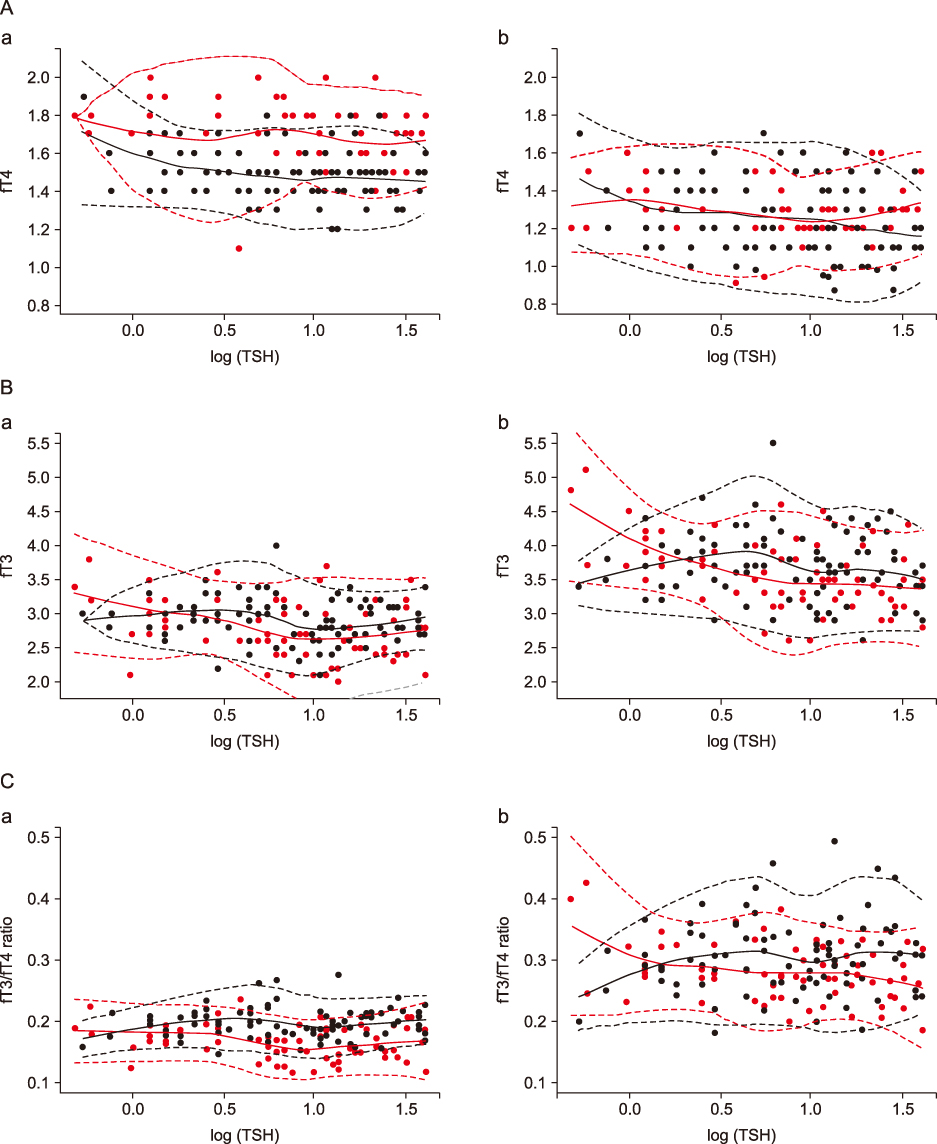Int J Thyroidol.
2019 May;12(1):28-34. 10.11106/ijt.2019.12.1.28.
Comparison of Thyroid Hormones in Euthyroid Athyreotic Patients Treated with Levothyroxine and Euthyroid Healthy Subjects
- Affiliations
-
- 1Department of Internal Medicine, Asan Medical Center, University of Ulsan College of Medicine, Seoul, Korea.
- 2Department of Nuclear Medicine, Asan Medical Center, University of Ulsan College of Medicine, Seoul, Korea. jsryu2@amc.seoul.kr
- 3Division of Nuclear Medicine, Department of Radiology, Hallym University Kangnam Sacred Heart Hospital, Hallym University College of Medicine, Seoul, Korea.
- 4Departments of Clinical Epidemiology, Biostatistics, Asan Medical Center, University of Ulsan College of Medicine, Seoul, Korea.
- 5Health Promotion Center, Asan Medical Center, University of Ulsan College of Medicine, Seoul, Korea.
- KMID: 2449063
- DOI: http://doi.org/10.11106/ijt.2019.12.1.28
Abstract
- BACKGROUND AND OBJECTIVES
Levothyroxine (L-T4) monotherapy to normalize TSH level might be not sufficient to restore serum free triiodothyronine (fT3) levels in hypothyroid patients. This study aimed to compare the thyroid hormone levels in euthyroid L-T4 treated athyreotic patients and euthyroid healthy control subjects.
MATERIALS AND METHODS
We included 69 euthyroid L-T4 treated athyreotic female patients after total thyroidectomy and radioactive iodine ablation therapy and 90 euthyroid healthy female. Serum fT3 and free thyroxine (fT4) levels were simultaneously measured using two different assay kits (A and B).
RESULTS
The serum fT4 level was higher in the athyreotic patients (kit A: p<0.001, kit B: p=0.046), and the serum fT3 level was higher in control subjects (kit A: p=0.047, kit B: p=0.102). In the control group, the serum fT3 level was stable and not correlated with the TSH level (kit A: tau=−0.10, p=0.18, kit B: tau=−0.06, p=0.40). However, in the patient group, the serum fT3 level was negatively correlated with the TSH level (kit A: tau=−0.22, p=0.012, kit B: tau=−0.31, p<0.001). All thyroid hormone parameters measured by kit A showed higher area under the curve values than those measured by kit B for distinguishing the patients from the control subjects.
CONCLUSION
The serum fT3 levels in L-T4 treated athyreotic euthyroid patients were significantly lower than and varied from those of euthyroid healthy control subjects. Thus, L-T4 monotherapy might not be appropriate for some athyreotic patients to maintain optimal T3 levels.
Keyword
MeSH Terms
Figure
Reference
-
1. Kelderman-Bolk N, Visser TJ, Tijssen JP, Berghout A. Quality of life in patients with primary hypothyroidism related to BMI. Eur J Endocrinol. 2015; 173(4):507–515.
Article2. Jeon MJ, Kim WG, Kwon H, Kim M, Park S, Oh HS, et al. Excessive iodine intake and thyrotropin reference interval: Data from the Korean National Health and Nutrition examination survey. Thyroid. 2017; 27(7):967–972.
Article3. Garber JR, Cobin RH, Gharib H, Hennessey JV, Klein I, Mechanick JI, et al. Clinical practice guidelines for hypothyroidism in adults: Cosponsored by the American Association of Clinical Endocrinologists and the American Thyroid Association. Thyroid. 2012; 22(12):1200–1235.
Article4. Jonklaas J, Bianco AC, Bauer AJ, Burman KD, Cappola AR, Celi FS, et al. Guidelines for the treatment of hypothyroidism: Prepared by the american thyroid association task force on thyroid hormone replacement. Thyroid. 2014; 24(12):1670–1751.
Article5. Wiersinga WM. Paradigm shifts in thyroid hormone replacement therapies for hypothyroidism. Nat Rev Endocrinol. 2014; 10(3):164–174.
Article6. Wiersinga WM, Duntas L, Fadeyev V, Nygaard B, Vanderpump MP. 2012 ETA guidelines: The use of L-T4 + L-T3 in the treatment of hypothyroidism. Eur Thyroid J. 2012; 1(2):55–71.
Article7. Peterson SJ, McAninch EA, Bianco AC. Is a Normal TSH synonymous with “euthyroidism” in levothyroxine monotherapy? J Clin Endocrinol Metab. 2016; 101(12):4964–4973.
Article8. Gullo D, Latina A, Frasca F, Le Moli R, Pellegriti G, Vigneri R. Levothyroxine monotherapy cannot guarantee euthyroidism in all athyreotic patients. PLoS One. 2011; 6(8):e22552.
Article9. Hoermann R, Midgley JE, Larisch R, Dietrich JW. Relational stability of thyroid hormones in euthyroid subjects and patients with autoimmune thyroid disease. Eur Thyroid J. 2016; 5(3):171–179.
Article10. Koo TK, Li MY. A guideline of selecting and reporting intraclass correlation coefficients for reliability research. J Chiropr Med. 2016; 15(2):155–163.
Article11. Hoermann R, Midgley JE, Giacobino A, Eckl WA, Wahl HG, Dietrich JW, et al. Homeostatic equilibria between free thyroid hormones and pituitary thyrotropin are modulated by various influences including age, body mass index and treatment. Clin Endocrinol (Oxf). 2014; 81(6):907–915.
Article12. Panicker V, Saravanan P, Vaidya B, Evans J, Hattersley AT, Frayling TM, et al. Common variation in the DIO2 gene predicts baseline psychological well-being and response to combination thyroxine plus triiodothyronine therapy in hypothyroid patients. J Clin Endocrinol Metab. 2009; 94(5):1623–1629.
Article13. Hoermann R, Midgley JE, Larisch R, Dietrich JW. Is pituitary TSH an adequate measure of thyroid hormone-controlled homoeostasis during thyroxine treatment? Eur J Endocrinol. 2013; 168(2):271–280.
Article14. Wiersinga WM. THERAPY OF ENDOCRINE DISEASE: T4 + T3 combination therapy: Is there a true effect? Eur J Endocrinol. 2017; 177(6):R287–R296.15. Duntas LH, Wartofsky L. There is no ‘universal fit’: Reflections on the use of l-triiodothyronine in the treatment of hypothyroidism. Metabolism. 2016; 65(4):428–431.
Article16. Ito M, Miyauchi A, Hisakado M, Yoshioka W, Ide A, Kudo T, et al. Biochemical markers reflecting thyroid function in athyreotic patients on levothyroxine monotherapy. Thyroid. 2017; 27(4):484–490.
Article
- Full Text Links
- Actions
-
Cited
- CITED
-
- Close
- Share
- Similar articles
-
- A Case of Hyponatremia in Hypothyroidism
- Euthyroid Thyroperoxidase Antibody Positivity during Pregnancy, to Treat or Not to Treat?
- Free T4 is negatively correlated with body mass index in euthyroid women
- Euthyroid Sick Syndrome in Spinal Cord Injury: A report of 3 cases
- Free T4 is Negatively Correlated with Non-alcoholic Fatty Liver Disease in Euthyroid Women


